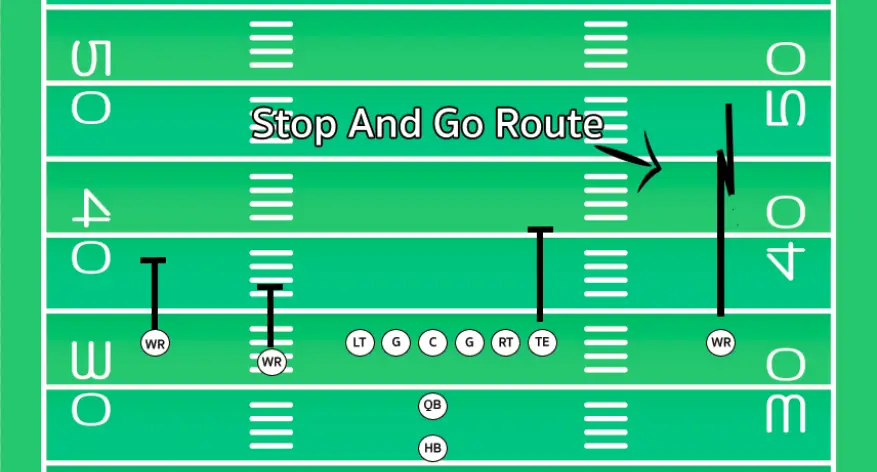A stop and go route in football is a receiving pattern in which a receiver fakes as if he is going to do run a curl route only to go route.
A hook route involves the receiver stopping and turning back towards the quarterback about ten yards downfield. A go route is a deep receiving pattern that has the receiver run in a straight line down the field.
On a stop and go route the intention is to trick the defender into thinking you are running the short hook route.
When running a hook route the defender should be over the top of the receiver meaning he will be deeper down the field. If the defender is to stop a hook route he is going to run towards the line of scrimmage in order to break up the pass.
This is how the hook and go route can effectively beat a defender. If the defensive back believes the receiver is running the hook route he will start moving towards the line of scrimmage.
As the defender moves closer to the receiver he will begin the go portion of the route which involves him sprinting straight down the field.
Since the defender’s momentum is going the opposite way it should be easy for the receiver to beat him downfield.
If there is no safety coverage over the top the receiver should be wide open deep downfield.
What To Know About Stop N Go Routes
Now that you know what a stop and go route is in football it is time to learn about the key factors that play into running this route.
Below we are going to break down some of the main things you should know about stop and go routes in football.
Significantly More Effective Against Single Coverage
One of the key things you should know about a stop and go route is that they are much more effective against single man coverage. This is the case for most routes but it is especially true for this one.
The purpose of this route is to trick the defensive back covering the receiver into believing the receiver is running a short route.
If there are multiple players covering that side of the field tricking the first defender into thinking the receiver is going short does not mean the receiver will get open.
Oftentimes teams will have the cornerback cover the short area of the field and have a safety overtop that watches for longer passes.
If this is the case the stop and go will not be effective. This is because tricking the first defender into believing the receiver is running a hook is not going to help.
That first defender is not meant to cover deep routes so it will have no real effect on the play.
The cornerback would simply pass the receiver off to the safety once he starts going deep.
This is why this route is most effective against single man coverage.
Long Developing Play
Another thing you should know about stop and go routes is that they are long developing plays. This means that the quarterback is going to need at least a few seconds of protection from defenders in order to get this throw off.
Since this receiving pattern involves two cuts instead of one this route is going to take longer than most.
This means that defensive players will have an opportunity to get to the quarterback when he attempts to make this throw. Teams with poor offensive lines will struggle to make plays like this happen due to the long-developing nature of the route.
Teams Often Build Up To This Doulbe Move
Another interesting component of stop and go routes is that teams will often spend the early portions of the game building up to this route.
The fake of running a hook is much more effective when the route has been run before. If a receiver is able to catch a few passes on hook routes the defenders are going to be more likely to bite on the fake.
Once the defender is aware of the hook route the offense can run the hook and go in order to take advantage of the situation.

